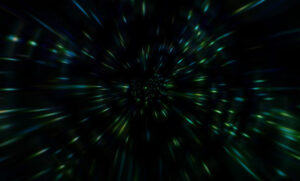Concept and Approach:
For this assignment my approach was inspired by a game I used to play with my siblings as a child. Every time we’d go out to play under the sun, we’d come back into the house to see a bunch of lines forming in our eyes as we close them based on the rays of light that hit our eyes. The harder we rubbed our eyes the more lines would form with tiny colored dots. The lines quickly disappeared and new ones formed constantly. Turns out these lines are called phosphenes and are considered to be images of light and color seen when eyes are closed. They could be indicators of serious health conditions, but in most cases they are just results of exposure to light, and rubbing of the eyes. I tried to recreate these images using the flocking system and boids. The particles in my sketch would start off moving around in a chaotic manner on the canvas, eventually they begin colliding and decreasing in number. A while later new ones appear repeating the same manner as the previous particles. The system is constantly changing and the movement of the particles is randomized.

I applied different forces to the boids’ class to achieve the mechanism I was looking for, and then I had a number of boids be created in the flock array through which each boid could be called to run and update. Similar to what we had done previously in the semester, the boids had mechanics of position, velocity, acceleration, etc. What is interesting in this however is that the bodies get impacted by their neighbors and the physics behind them changes accordingly. Once they collide with one another, they concentrate in the same area for a while and then disperse and disappear.
This collision and concentration element was a bit more difficult to achieve because I was unsure of how to navigate the forces exactly. However, drawing inspiration from a previous assignment that I had worked on, I realized that the first step is to measure the distance between the boids, and accordingly I could apply if statements. I created a loop that runs through all the boids, measures the distance between them, and then adds the ones in close proximity to the closeBoids array. From there, if there are more than two boids close to each other, their position is updated based on the center vector, this gives the spiraling effect when they collide. The second if statement looks into creating a concentration wherein more boids collide and continue spiraling, moving to the concentration center, then disperse away from the center. Finally, the else statement looks into activateing a concentration period if there isn’t one yet.
// Find close Boids and calculate the center of concentration
let closeBoids = [];
for (let i = 0; i < boids.length; i++) {
let other = boids[i];
if (this.position.dist(other.position) < 30 && other !== this) {
closeBoids.push(other);
}
}
if (closeBoids.length > 1) {
let center = createVector(0, 0);
for (let i = 0; i < closeBoids.length; i++) {
let boid = closeBoids[i];
center.add(boid.position);
}
center.div(closeBoids.length);
if (this.concentrationCountdown > 0) {
// If concentration countdown is active so its more than 0, move towards the concentration center
let direction = p5.Vector.sub(center, this.position);
direction.setMag(2);
this.applyForce(direction);
// Apply force away from the concentration center to simulate dispersing
let dispersalForce = p5.Vector.sub(this.position, center);
dispersalForce.setMag(0.5); // Adjust the strength of dispersal
this.applyForce(dispersalForce);
this.concentrationCountdown--;
} else {
// Otherwise, activate concentration for a brief period
this.concentrationCountdown = 60;
}
}
}
Reflection and Ideas:
I think this code relatively achieves what I had in mind but for future developments I could work on making the boids change their speed over time. So that when they come to disperse and disappear they start moving slowly because that is how I remember seeing them. Also, this will enhance the majestic feeling of the sketch further relating to the images of light we see when our eyes our closed. I attempted to introduce this element just through updating the velocity after dispersal, however that didn’t work. It could be a matter of introducing an entirely new vector and updating the velocity and acceleration accordingly, but that is something I could look into moving forward.
